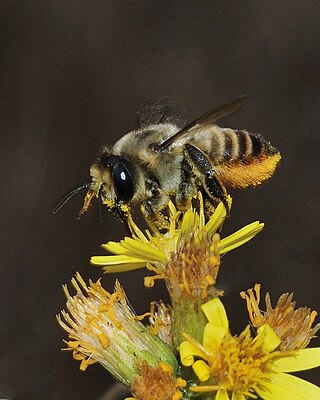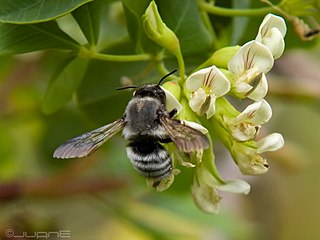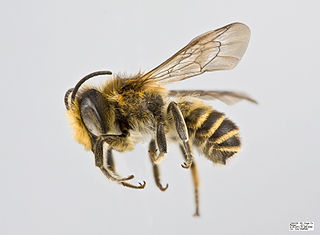
Lipinia is a genus of skinks, lizards in the family Scincidae. Species in the genus Lipinia are commonly called lipinias.

Megachilidae is a cosmopolitan family of mostly solitary bees. Characteristic traits of this family are the restriction of their pollen-carrying structure to the ventral surface of the abdomen, and their typically elongated labrum. Megachilid genera are most commonly known as mason bees and leafcutter bees, reflecting the materials from which they build their nest cells ; a few collect plant or animal hairs and fibers, and are called carder bees, while others use plant resins in nest construction and are correspondingly called resin bees. All species feed on nectar and pollen, but a few are kleptoparasites, feeding on pollen collected by other megachilid bees. Parasitic species do not possess scopae. The motion of Megachilidae in the reproductive structures of flowers is energetic and swimming-like; this agitation releases large amounts of pollen.

The genus Megachile is a cosmopolitan group of solitary bees, often called leafcutter bees or leafcutting bees; it also includes the called resin bees and mortar bees. While other genera within the family Megachilidae may chew leaves or petals into fragments to build their nests, certain species within Megachile neatly cut pieces of leaves or petals, hence their common name. This is one of the largest genera of bees, with more than 1500 species in over 50 subgenera. The alfalfa leafcutter bee is managed on a commercial scale for crop pollination, and has been introduced by humans to various regions around the world.
Barygenys cheesmanae is a species of frogs in the family Microhylidae. It is endemic to eastern New Guinea and is only known from Mount Tafa in Central Province, Papua New Guinea. The specific name cheesmanae honors Lucy Evelyn Cheesman, an English entomologist, explorer, curator at London Zoo, and collector of the holotype. Common name Cheesman's Papua frog has been coined for this species.

Cophixalus cheesmanae is a species of frog in the family Microhylidae. It is endemic to Papua New Guinea. Its natural habitats are subtropical or tropical moist lowland forests and subtropical or tropical moist montane forests.
Cornufer cheesmanae is a species of frog in the family Ceratobatrachidae. It is endemic to New Guinea and found in the Cyclops Mountains and Bewani Mountains. The specific name cheesmanae honors Lucy Evelyn Cheesman, an English entomologist, explorer, and curator at London Zoo. Common name Cheesman's wrinkled ground frog has been coined for it.
Lucy Evelyn Cheesman was a British entomologist and traveller. Between 1924 and 1952, Cheesman went on 8 solo expeditions in the South Pacific, and collected over 70,000 specimens, which she accompanied with sketches and notes. These are now part of the collections of the Natural History Museum in London. Cheesman published extensively about her work and travels. In 1955, she was appointed an OBE for her services to science.
Exocelina cheesmanae is a species of diving beetle. It is part of the genus Exocelina in the subfamily Copelatinae of the family Dytiscidae. It was described by J. Balfour-Browne in 1939.

Megachile campanulae, known as the bellflower resin bee, is a species of bee in the family Megachilidae. Described in 1903, these solitary bees are native to eastern North America. Studies in 2013 placed them among the first insect species to use synthetic materials for making nests. They are considered mason bees, which is a common descriptor of bees in several families, including Megachilidae. Within the genus Megachile, frequently also referred to as leafcutter bees, M. campanulae is a member of the subgenus Chelostomoides, which do not construct nests from cut leaves, but rather from plant resins and other materials. Females lay eggs in nests constructed with individual cell compartments for each egg. Once hatched, the eggs progress through larval stages and subsequently will overwinter as pupae. The bees are susceptible to parasitism from several other bee species, which act as brood parasites. They are medium-sized bees and the female adults are typically larger than the males. They are important pollinators of numerous native plant species throughout their range.
Chelostomoides is a subgenus of bees in genus Megachile. These bees do not cut leaves, but rather, use resin, mud, or other materials

Megachile gentilis is a species of bee in the family Megachilidae. It was described by Cresson in 1872.

Megachile texana, the Texas leafcutter bee, is a species of bee in the family Megachilidae. It was first described by the American entomologist Ezra Townsend Cresson in 1878. It is native to the United States and southern Canada.
Megachile venusta is a species of bee in the family Megachilidae. It was described by Smith in 1853.

Megachile versicolor is a species of bee in the family Megachilidae. It was described by Smith in 1844.

Megachile canescens is a species of bee in the family Megachilidae. It was described by Brullé in 1832.

Megachile centuncularis, commonly known as the patchwork leafcutter bee, is a species of bee in the family Megachilidae. It was first described by the Swedish naturalist Carl Linnaeus in 1758.

Megachile parietina is a species of bee in the family Megachilidae. It was described by Geoffroy in 1785. It is native to most of central Europe, as well as parts of eastern Europe.

Callomegachile is a subgenus of the bee genus Megachile in the family Megachilidae.
Lipinia cheesmanae, also known commonly as Cheesman's lipinia and Cheesman's moth skink, is a species of skink, a lizard in the family Scincidae. The species is endemic to Indonesia.











